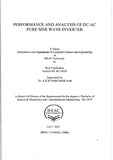Performance and analysis of DC-AC pure sine wave inverter

View/
Date
2010-12-08Publisher
BRAC UniversityAuthor
Purification, PaulMetadata
Show full item recordAbstract
Energy crisis are of special attention in today's world. The unending usage of non-renewable energy sources will bring an end to the limited resources in near future. In order to preserve the resources, several alternative renewable sources have been in use these days. The power generated from the renewable sources, like solar energy, produces is a DC power which can be stored in batteries. This DC power needs to be converted to AC power as most of the appliances used in our daily life are dependent on AC power. To overcome this obstacle, DC-AC Inverter took birth.Inverter s can be categorized into three groups: Square wave, modified sine wave and pure sine wave. Considering power wattage, efficiency and harmonic content, pure sine wave inverters has proved to have the best quality among the three types. The control circuit for pure sine wave inverter produces sinusoidal pulse width modulation. There are two basic topologies to generate pulse width modulation¬Topology 1: Analog Control circuit and Topology 2: Microcontroller based control circuit.In this thesis project, performance of both topologies used in inverters has been analyzed and a DC-AC pure sine wave Inverter using the Analog control circuit (Topology 1) has been implemented.
